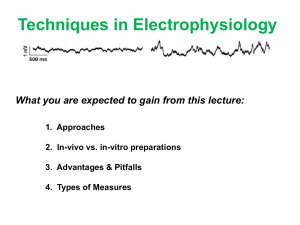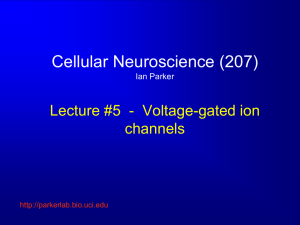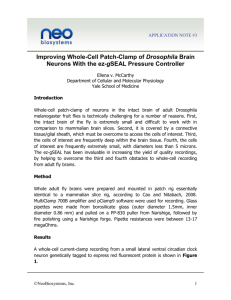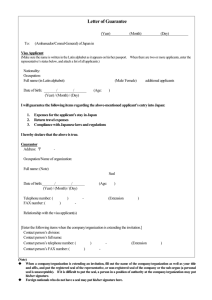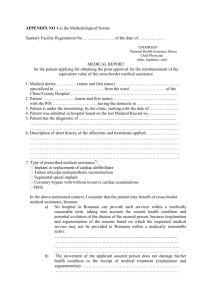Experiences of a New - NeoBiosystems, Inc.
advertisement
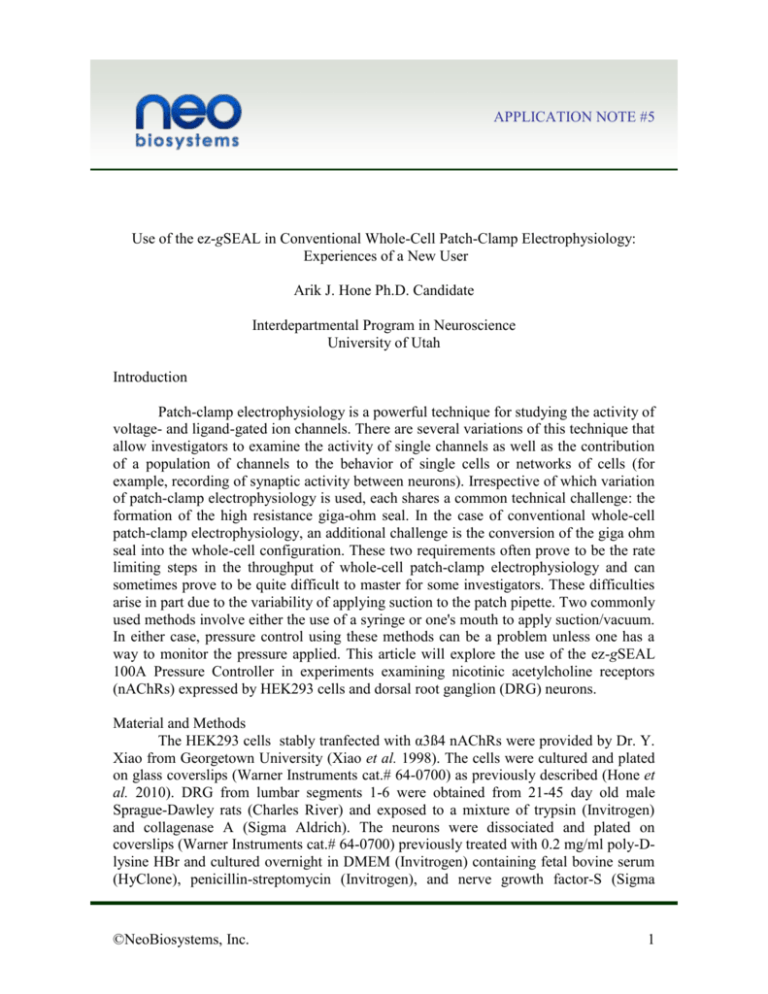
APPLICATION NOTE #5 Use of the ez-gSEAL in Conventional Whole-Cell Patch-Clamp Electrophysiology: Experiences of a New User Arik J. Hone Ph.D. Candidate Interdepartmental Program in Neuroscience University of Utah Introduction Patch-clamp electrophysiology is a powerful technique for studying the activity of voltage- and ligand-gated ion channels. There are several variations of this technique that allow investigators to examine the activity of single channels as well as the contribution of a population of channels to the behavior of single cells or networks of cells (for example, recording of synaptic activity between neurons). Irrespective of which variation of patch-clamp electrophysiology is used, each shares a common technical challenge: the formation of the high resistance giga-ohm seal. In the case of conventional whole-cell patch-clamp electrophysiology, an additional challenge is the conversion of the giga ohm seal into the whole-cell configuration. These two requirements often prove to be the rate limiting steps in the throughput of whole-cell patch-clamp electrophysiology and can sometimes prove to be quite difficult to master for some investigators. These difficulties arise in part due to the variability of applying suction to the patch pipette. Two commonly used methods involve either the use of a syringe or one's mouth to apply suction/vacuum. In either case, pressure control using these methods can be a problem unless one has a way to monitor the pressure applied. This article will explore the use of the ez-gSEAL 100A Pressure Controller in experiments examining nicotinic acetylcholine receptors (nAChRs) expressed by HEK293 cells and dorsal root ganglion (DRG) neurons. Material and Methods The HEK293 cells stably tranfected with α3ß4 nAChRs were provided by Dr. Y. Xiao from Georgetown University (Xiao et al. 1998). The cells were cultured and plated on glass coverslips (Warner Instruments cat.# 64-0700) as previously described (Hone et al. 2010). DRG from lumbar segments 1-6 were obtained from 21-45 day old male Sprague-Dawley rats (Charles River) and exposed to a mixture of trypsin (Invitrogen) and collagenase A (Sigma Aldrich). The neurons were dissociated and plated on coverslips (Warner Instruments cat.# 64-0700) previously treated with 0.2 mg/ml poly-Dlysine HBr and cultured overnight in DMEM (Invitrogen) containing fetal bovine serum (HyClone), penicillin-streptomycin (Invitrogen), and nerve growth factor-S (Sigma ©NeoBiosystems, Inc. 1 Aldrich). Electrophysiological experiments were performed within 48 hours after plating. The extracellular solution used for all experiments contained 145 mM NaCl, 5 mM KCl, 2 mM CaCl2, 1 mM MgCl2, 10 mM D-glucose and 10 mM HEPES. The pH of the solution was adjusted to 7.4 with NaOH and the osmolarity was 310 mOsm. The patch pipettes were pulled using a P97 puller (Sutter Instruments) and had resistances of 2-4 MegOhms when filled with solution containing 140 mM KCl, 5 mM NaCl, 1 mM CaCl2, 2 mM Na-ATP, 10 mM EGTA, and 10 mM HEPES. The pipette solution was adjusted to pH 7.2 with KOH and the osmolarity was 308 mOsm. Acetylcholine was delivered with a patch pipette, filled with 1 mM acetylcholine chloride in extracellular solution, by pressure ejection using a Picospritzer (General Valve Corp.). The α-conotoxin ArIB[V11L;V16D] was synthesized in house (Whiteaker et al. 2007). Whole-cell recordings were made with an Axopatch 200B amplifier (Molecular Devices), current signals were filtered at 1 kHz and digitized at 5 kHz using a USB-6009 digitizer (National Instruments) controlled by homemade software written in LabVIEW (National Instruments). All experiments were performed under visual control using 40x (0.8 N.A.) objective with DIC optics and a Nikon DS-Qi1Mc CCD camera. Results To initiate whole-cell patch-clamp recordings of HEK293 cells, a positive pressure of 5 mm Hg was applied to the patch pipette using the ez-gSEAL 100A. The pipette was advanced towards the cell until a dimpling of the cell membrane was observed at which point the pressure was quickly changed to 0 mm Hg. In 9/12 cells, this provided a giga-Ohm seal formation within 30 sec. In the remaining 3 cells, application of a -1 mm Hg suction resulted in seal formation. To convert from a high resistance seal to the whole-cell configuration, a 500 msec -120 mm Hg pulse was used. If intracellular access was not obtained at this setting, the pressure was increased by -20 mm Hg increments until break-in was achieved. This method resulted in obtaining access in 10/12 cells (the seals in two cells were deemed unacceptable, so whole-cell access was not attempted). DRG neurons required the investigation of several pressure parameters for optimal seal formation and for obtaining whole-cell access. Furthermore, there was considerably more variability between neurons in terms of the parameters used relative to those for HEK293 cells. Optimal results were obtained by advancing the pipette towards the neuron with 5 mm Hg pressure and upon contact switching the pressure to -1 mm Hg, then to -40 mm Hg, then back to -1 mm Hg and held here until seal formation. In general, the pulse to -40 mm Hg was brief to avoid sucking the cell membrane up the pipette which was observed in some neurons if held at -40 mm Hg for too long. Seal formation, as monitored by increased resistance, generally began at the initial -1 mm Hg step and rapidly formed during the brief -40 mm Hg step. In some cases, however, the seal didn’t quite form completely while being held at -1 mm Hg. In these cases the high resistance seal could be coaxed into forming by increasing the steady-negative pressure in -1 mm Hg increments (up to -10 mm Hg) until the seal completely formed. The membrane was closely monitored visually at these negative pressures to avoid sucking the membrane up the pipette. Using these procedures, successful seal formation was obtained in 13/16 neurons. In two cases, seal formation failed and in one case whole-cell access occurred during the -40 mm Hg step. ©NeoBiosystems, Inc. 2 Similar procedures were used for obtaining whole-cell access with both HEK293 and DRG cells, but with a greater initial negative starting pressure for the latter cells. A 500 msec pulse starting at -140 mm Hg was used and increased by -20 mm Hg increments until access was obtained. Whole-cell access was successfully obtained in 9/13 neurons. Figure 1. Whole-cell voltage-clamp recording of acetylcholine evoked responses from a DRG neuron held at -80 mV. Acetylcholine (1 mM) was applied in 50 msec puffs at 2 min intervals from a pipette whose tip was ~50 m from the neuron. The responses were blocked during a 10 min perfusion with300 nM α-conotoxin ArIB[V11L;V16D], a specific antagonist of the α7 subtype of nAChRs. The responses recovered from block during wash-out of the toxin. The time scale bar applies to the response traces only; acetylcholine was applied at 2 min intervals. Discussion A major advantage of the ez-gSEAL 100A Pressure Controller over conventional syringe or mouth suction methods is the ease which the user can precisely and reproducibly regulate the amount of pressure and vacuum applied to obtain the high resistance seal and whole-cell access. Computer controlled operation replaces manual user input and produces more consistent results. The second advantage is the ability to communicate methods for achieving good results to new patch clampers. In this case, as detailed above, users can describe parameters in quantitative terms that cannot be readily conveyed using conventional methods. These two advantages facilitate the ease of acquiring the skills for successfully employing the patch-clamp technique and reduce learning time resulting in what every investigator desires: more data. Acknowledgements Drs. D. Yoshikami and J. M. McIntosh for critical review of this article. References Hone, A. J., Whiteaker, P., Mohn, J. L., Jacob, M. H. and McIntosh, J. M. (2010) Alexa Fluor 546ArIB[V11L;V16A] is a potent ligand for selectively labeling alpha7 nicotinic acetylcholine receptors. J Neurochem, 114, 994-1006. ©NeoBiosystems, Inc. 3 Whiteaker, P., Christensen, S., Yoshikami, D., Dowell, C., Watkins, M., Gulyas, J., Rivier, J., Olivera, B. M. and McIntosh, J. M. (2007) Discovery, synthesis, and structure activity of a highly selective alpha7 nicotinic acetylcholine receptor antagonist. Biochem, 46, 6628-6638. Xiao, Y., Meyer, E. L., Thompson, J. M., Surin, A., Wroblewski, J. and Kellar, K. J. (1998) Rat alpha3/beta4 subtype of neuronal nicotinic acetylcholine receptor stably expressed in a transfected cell line: pharmacology of ligand binding and function. Mol Pharmacol, 54, 322-333. Gauge www.neobiosystems.com info@neobiosystems.com ©NeoBiosystems, Inc. 1407 Heckman Way, San Jose, CA 95129 Phone 408-454-6026 Fax 408-689-6148 4
